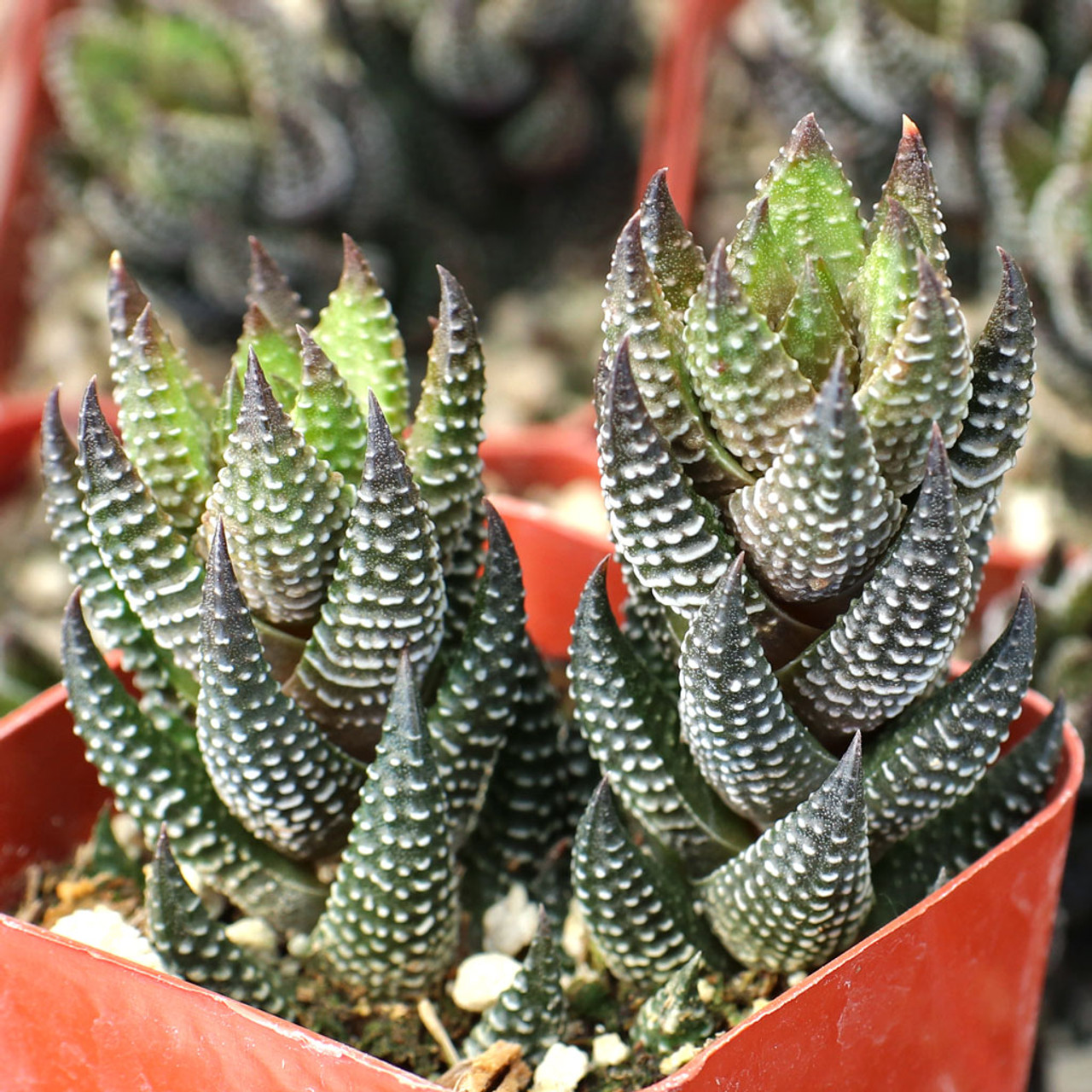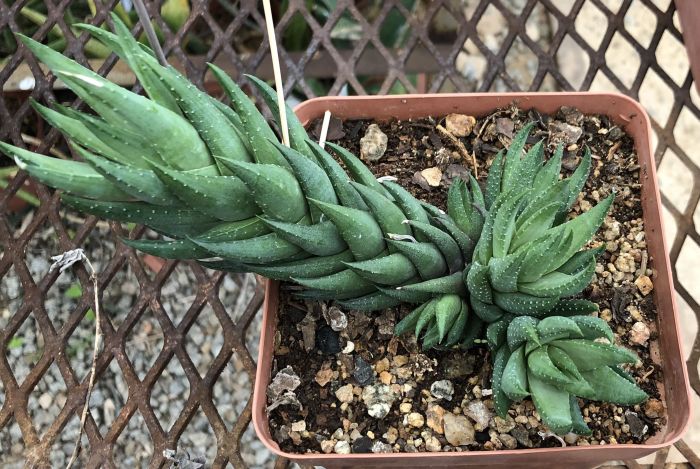This clumping, slow-growing succulent has dark green leaves with white stripes that can turn a pinkish-purple hue when it is exposed to intense sunlight or colder temperatures. Its tall stems are topped with short, curved foliage.
Table of Contents
Care and Propagation Information
Haworthiopsis coarctata is an ideal choice for a rock garden. It provides great visual complexity to a succulent display, and in the summertime, you can expect to see green blooms.
Watering
Haworthiopsis coarctata will require the typical amount of water for a succulent. It is recommended to use the “soak and dry” method, meaning the soil should be thoroughly soaked and then allowed to dry out completely before the plant is watered again.
Where to Plant
Haworthiopsis coarctata is not tolerant of cold temperatures and should not be planted in areas that experience temperatures lower than 0° F (-1.1° C). If you live in a region with such cold weather, it is best to grow this succulent in a container that can be brought indoors. For optimal growth, place it in an area with full to partial sun, allowing it at least 6 hours of direct sunlight each day.
Commonly Mistaken For
The leaves of Haworthiopsis coarctata are smaller, wider, and smoother than those of its relative, Haworthia reinwardtii.
How to Propagate Haworthiopsis coarctata
Offsets
Haworthiopsis coarctata will create miniature offshoots around the bottom of the plant. To propagate, pull the offsets off and let them dry for between one and two days before planting them again.
Leaves
Plant the leaf in a container filled with a well-draining, sandy soil. Place the container in bright, indirect light and water it occasionally. The leaf should take root and form a small rosette of leaves.
Let the leaf heal for a few days, then place it on potting soil that drains well. Water it when the soil is totally dry. Once roots and a new set of leaves have grown, transplant it into soil and discard the old leaf.
Seeds
If you want to propagate Haworthiopsis from seeds, it’s best to sow them in a soil that drains well in the autumn. If you live in an area with a mild climate (zone 9a or above), you can plant the seeds outside. However, if you’re in a cooler area, you should start them indoors in a spot with a grow light.
Care and Propagation Information
General Care for Haworthiopsis coarctata
Haworthiopsis coarctata is an ideal choice for a rock garden. It provides great visual complexity to a succulent display, and in the summertime, you can expect to see green blooms.
Watering
Haworthiopsis coarctata will require the typical amount of water for a succulent. It is recommended to use the “soak and dry” method, meaning the soil should be thoroughly soaked and then allowed to dry out completely before the plant is watered again.
Where to Plant
Haworthiopsis coarctata is not tolerant of cold temperatures and should not be planted in areas that experience temperatures lower than 0° F (-1.1° C). If you live in a region with such cold weather, it is best to grow this succulent in a container that can be brought indoors. For optimal growth, place it in an area with full to partial sun, allowing it at least 6 hours of direct sunlight each day.
Commonly Mistaken For
The leaves of Haworthiopsis coarctata are smaller, wider, and smoother than those of its relative, Haworthia reinwardtii.
How to Propagate Haworthiopsis coarctata
Haworthiopsis coarctata reproduces easily, producing many new plants through offsets. It is also possible to propagate the species through seeds and leaves.
Offsets
Haworthiopsis coarctata will create miniature offshoots around the bottom of the plant. To propagate, pull the offsets off and let them dry for between one and two days before planting them again.
Leaves
Plant the leaf in a container filled with a well-draining, sandy soil. Place the container in bright, indirect light and water it occasionally. The leaf should take root and form a small rosette of leaves.
Let the leaf heal for a few days, then place it on potting soil that drains well. Water it when the soil is totally dry. Once roots and a new set of leaves have grown, transplant it into soil and discard the old leaf.
Seeds
If you want to propagate Haworthiopsis from seeds, it’s best to sow them in a soil that drains well in the autumn. If you live in an area with a mild climate (zone 9a or above), you can plant the seeds outside. However, if you’re in a cooler area, you should start them indoors in a spot with a grow light.
FAQ
How do you grow haworthia Coarctata?
Haworthiopsis coarctata is not tolerant of temperatures below 0° F (-1.1° C), so if you live in a colder climate, it is best to keep this succulent in a pot that can be brought indoors. It grows best when exposed to full to partial sunlight, so choose a location in your garden that gets at least 6 hours of sun daily.
Can Haworthia be propagated in water?
These can be removed from the mother plant and re-potted. Growing haworthia from seed is more tricky, as seeds must be kept in warm, humid conditions in order to germinate. This can be achieved by using a propagator or by covering the seed tray with a plastic bag. Propagating haworthia from leaves is a simple process. Leaves can be placed in either soil or water, and the new haworthia will begin to grow roots and eventually form a new plant.
What is haworthia coarctata used for?
Haworthiopsis coarctata is a great choice for a rock garden. It can help provide texture and visual interest to a succulent display. Blooming with green flowers in the summer, it makes a great addition.
How big does haworthia coarctata grow?
Haworthiopsis coarctata is a plant with sturdy, fleshy foliage, covered in unique white, pearl-like warts or stripes. Its stems can extend up to 200 mm in height, and they become longer as the plant matures, with the rosettes of leaves reaching 300 mm in length.
How do you propagate Haworthiopsis coarctata?
Rephrase: – Take a strong leaf from the plant and carefully detach it from the stem.
– Let the leaf rest for a few days until it forms a protective layer.
– Do not put the leaf into the soil.
– Place it on the soil instead.
– Make sure the dirt you use for the cuttings or offsets has good drainage.



